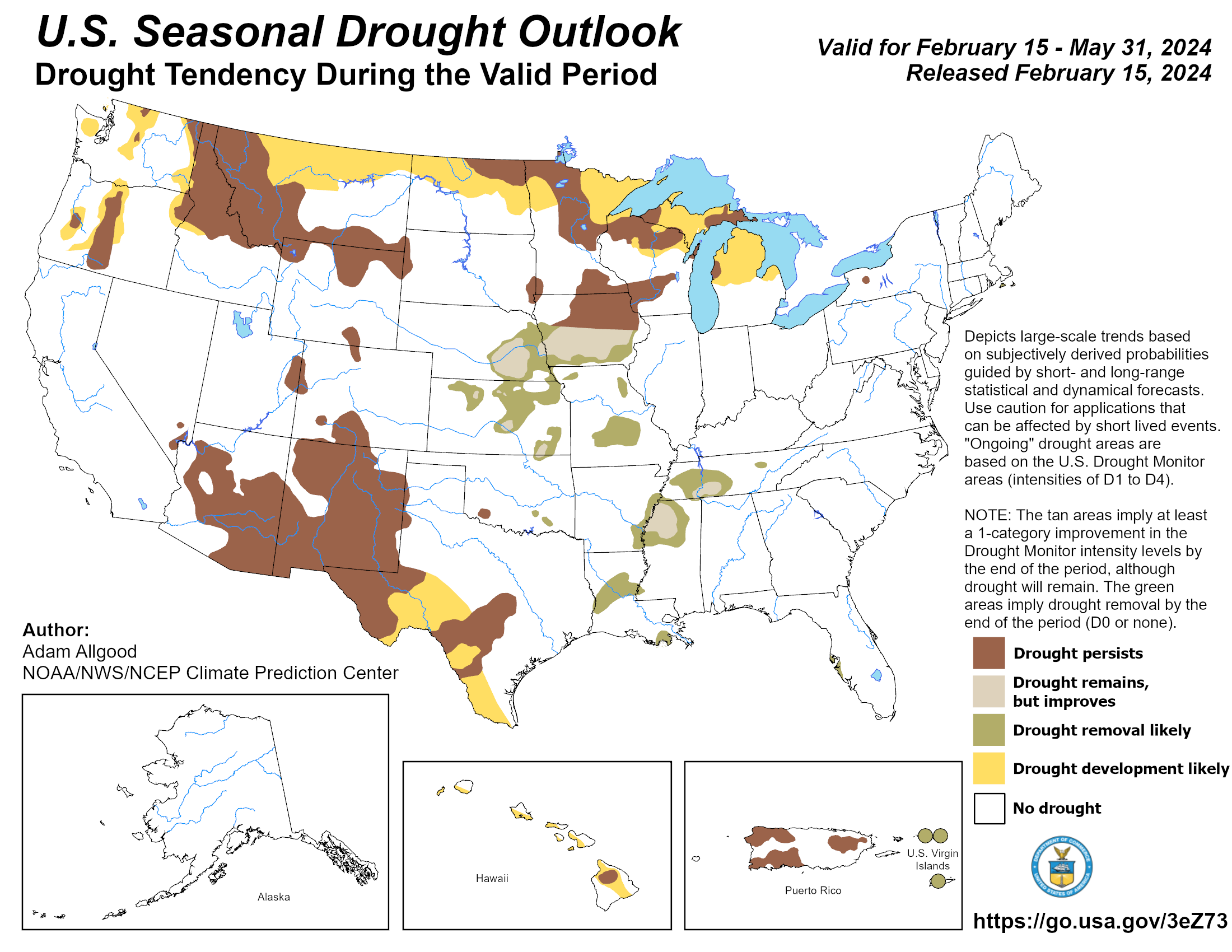
Seasonal temperature predictions indicate early spring. (Photo: National Weather Service)
Early Spring Predictions Unveiled
February 28, 2024
The weather is very much like a roller coaster – the ups and downs, quick turns and that nauseating feeling one feels after a bumpy ride.
Farmers know all too well that feeling, especially if they plant too early and then a sudden cold snap damage the crop. What if there is a deluge of rainfall or worse, no rain at all?
There are many variables in farming – input costs, market volatility, equipment issues, technology. The weather, however, may be the most unpredictable.
That said, there are some models and predictions from those in the business of weather and how it might impact those in the field this spring.
Warming up
Iowa State Climatologist Justin Glisan says the three-month period of April, May and June is mixed.
“The seasonal outlooks for spring are showing an elevated signal for warmer temperatures and no clear signal on the precipitation side,” he says. “In the modeling, we are seeing a potential transition from the current strong El Nino pattern back to El Nino-Southern Oscillation (ENSO)-neutral in the April-May-June period and then back to a weak La Nina into later summer. There is a low correlation between the phase of ENSO and summertime weather since much of the rainfall is thunderstorm-driven.”
According to the National Weather Service (NWS), temperature and precipitation outlooks for March are influenced by El Niño and model output, while leaning toward long-term trends thereafter into the spring season. There are increasing chances of a La Niña developing by late summer and into the autumn season.
The NWS indicates much of Iowa is leaning toward above-normal temperatures for the next three months; the southwest corner of Iowa has an equal chance of falling into the above or below-normal category.

But will it rain?
Glisan says as for wintertime precipitation, December was the third warmest and 27th wettest on record, January was the 18th wettest.
“Most of the rain and record snowfall soaked into the soil profile, so we’ve had some drought improvement and additional moisture in the tank for the upcoming growing season,” he says.
But most of Iowa is still short on soil moisture, which reflects 189 weeks of drought … the longest drought since 1954-58, Glisan adds.
“We’ll need a very wet stretch of months into 2025 to refill profiles completely and start recharging aquifers and alluvials,” he says. “Once we see wetter soils, we’ll get more runoff and a rebound in particularly dry streams and rivers. Snow drought across the Upper Midwest tamps down on spring flood potential, though we’d like to see runoff into the Missouri and Mississippi basins to get the river levels up.”
According to the NWS, southern Iowa has an above average shot of precipitation now through May; the northern half of the state – an equal chance of falling into the above normal or below normal category.
As far as the overall drought is concerned, NWS forecasters indicate drought conditions will persist in the southern half of Iowa but there will be improvement; much of the northern half of Iowa, however, will continue in a drought pattern with the northwest corner of the state falling into the “no drought” category for the next three months.

'A grain of salt'
ISA farmer-member Reed Burres of Humboldt County says while weather predictions may offer some insights into what might happen, he recognizes that there are no guarantees that the rain will fall or the sun will shine.
"I put some stock into weather forecasts, but I take those predictions with a grain of salt," he says.
Burres says, like all farmers, he has to adjust accordingly, especially when weather patterns can deviate greatly from different parts of the state.
He says drought conditions have persisted over the past few years in north central Iowa, so he plans and markets differently compared to other farmers who may have had their fair share of rainfall.
"In the last few years, we're just hoping for heavy dews in the morning," Burres says, adding he remains optimistic regardless of what the forecast may indicate.
Fellow ISA farmer-member Matt Diehl agrees.
While he doesn't put a faith in long-range weather forecasts, he knows through experience that he and other farmers know how to operate on the fly.
"At the end of the day, we do what we feel is best for our fields, and hope for the best when it comes to the weather," says Diehl, who lives in south central Iowa near Osceola.
"It seems like lately it's one extreme to another - either it's too dry or it's too wet," he says. "I know last year it was really dry, but I had some of the best beans and corn I've ever had."
March 19 is the first day of spring.
Back